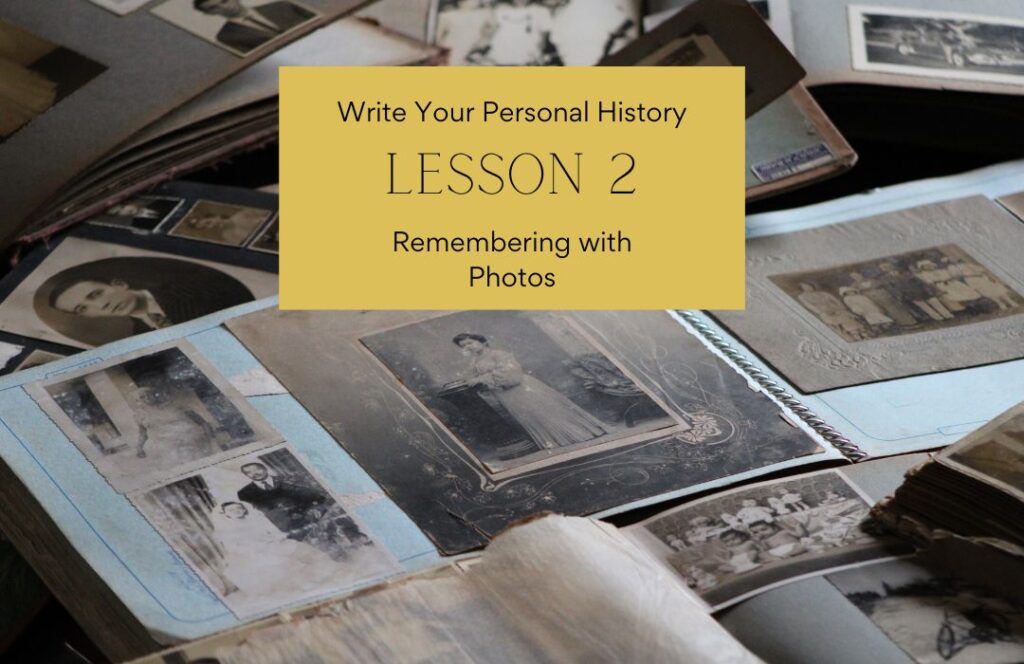
Personal History Course, Lesson 2
You’ve recorded your first story! Congratulations!
Our next project is a fun one. We get to start thinking about how to illustrate your story. Before we get going, let’s identify some reasons you might want to leave a photo of yourself for future generations.
Making Photographs Part of Your Family Story
Pictures are a way of capturing a single moment in time and preserving that moment for the future. Photographs are a powerful means of preserving memories. Preserving memories and passing down family stories can be a critical component of helping our descendants understand their own identity, develop resilience, and feel a solid sense of belonging as part of a family.
The visual input from a photo can invoke additional input from other senses. I can still smell my grandmother’s Dove soap when I see a photo of Thanksgiving Dinner taken at her home. My mouth will water at the memory of how good her Parker House rolls were. Today, I found this image of my Grandparents. The note in my scrapbook says I took this picture with a camera I received for my 11th birthday. It was 1977.

Ruth and Mark Tanner, 1977
The memories this photo evokes go way beyond what is pictured in the image itself. I can imagine what Grandma’s roses smelled like. The bush was nearly as tall as the house! She’s wearing a dress she made herself. They are standing in front of the cinder block home Grandpa built with his own hands. I am enjoying a flood of happy memories as I recall other details. Grandma’s cat’s-eye glasses. Grandpa’s impish grin. Oh how I loved them!
We can piece together memories of all kinds of happy (and sad) moments by looking at details in a photograph. Details as mundane as the wallpaper behind the subjects of the photo, or the style of their clothing can help us recall specific memories.
Photos Help Us Process Our Grief from Sadness to Sweetness
Because we often photograph life’s best moments—birthdays, family vacations, graduations—the feelings associated with these happier times can aid us in times of distress and grief. Recalling good memories helps us heal from loss. Because photographs can preserve more than facial features, they are also helpful for making memories of the happy parts of a person’s life more fluid.
Even without these beneficial psychological impacts, pictures are powerful as illustrations for our stories. I could describe to someone that my grandmother had a green thumb, but you begin to understand what that means when you see her rosebushes. I could tell how I never saw Grandma’s hair unkempt, but seeing her hairdo in living color gives my grandchildren, who never knew her, a better frame of reference. One of my granddaughters is named after Grandma Ruth. Imagine how much more a photo like this could help her understand about her heritage. And it’s not even a great photo!
The Story of a Favorite Photograph
My paternal grandmother kept a large photo of a dark-haired, unsmiling woman above the head of her bed, and as a child, I wondered why. When I was old enough, she explained that this was a photo of Hattie, Grandpa Harold’s mother, who had died just days after he was born.

Harriet (Hattie) Anna Johnson Whiting, in the wedding gown she sewed herself, 1906
The photo, I later learned, was an enlargement of Hattie from a photograph taken on her wedding day. She sewed the wedding gown she was wearing. Now, we are starting to flesh out who Hattie was just a little more.
Another beautiful piece of the story of this photograph is how it came to hang in my grandparents’ bedroom. Four years after Hattie died, her husband, Jim, remarried. His second wife, Beulah, had an enlargement made from this photo of Hattie. She framed it, then hung it in her living room after she and Jim were married. Beulah wanted to preserve the memory of Hattie for her husband and the 4-year-old son who had no other way to remember his birth mother. I have never fully wrapped my head around the unselfishness of that act, but knowing a second wife would preserve the memory of the first wife in this tender, selfless way has always made me love both women better.
After Beulah’s death, the portrait was given to Harold, and it hung above his bed for the rest of his life. That’s the power of a photograph. To my knowledge, there are only 5 photographs of Hattie in existence. This one is precious to the entire family, for reasons that story only begins to explain.
Let’s take just a little bit of time to learn how to gather and preserve photographs of you so that they’ll still be around 100 years from now. It’s time to move on to Lesson #3: Find 50 Great Photos of Yourself.


